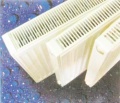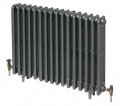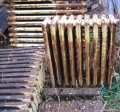Central heating radiators
This article is about various types of radiators used in Central heating systems. There is more information about designing central heating systems in
- Central Heating Design, whilst
- Underfloor Heating discusses a significant alternative to radiators.
There are separate articles about:
- Central heating operation for help maintaining a working CH system
- Central Heating Repair for diagnosing and fixing a faulty system.
Types
Radiators comes in a number of types, shapes and sizes. Most are finished with a heat resistant white paint.
Standard radiators
These are available in a range of heights typically between 300 and 750mm with the greatest range of lengths and configurations in heights around 450 to 600mm high. Lengths range from 200mm to 3m or more with the greatest range around 450mm to 2m long. Colour is generally white.
Panels and Convectors
Radiators generally have one or two panels, although 3-panel types are sometimes found. Modern single-panel radiators have a corrugated panel forming a series of fins (called "convectors") attached to the back (wall-facing) side of the panel, which increases the convection output of the radiator. These are usually known as "single convector" (SC). Radiators comprising two panels-with-fins sandwiched together (with the fins in the middle) are known as "double convectors" (DC). There are also double radiators comprising one finned panel and one panel without fins: these are known as "double panel plus" or "double panel extra" and will be referred to here as DX. Older radiators comprised one or two panels without any convection fins: these are referred to here as SP and DP respectively. In the case of the double types the two panels are much closer together than on DX or DC radiators. SP (single panel un-finned) radiators are still available as part of Barlo's round-top range.
Seam-top, round-top and compact
The traditional standard radiator has seams at the top, sides and bottom of each panel (where pressed sheets of steel are joined together). These are sometimes known as "seam-top".
Nowadays most seam-top radiators are sold with decorative panels fitted to the top and sides (the top ones having ventilation slots to allow air circulation), and are known as 'compact' radiators. These types are widely available, from outlets such as B&Q, Screwfix, Toolstation and SELCO as well as traditional plumbers' and heating merchants.
An alternative to the seam-top design uses one sheet of pressed steel folded to make a radiator with a rounded (or roll) top. Typical of this type are Barlo radiators, although Myson also produce them (as their "Premier HE" range) as are Wickes' own brand (in a limited range of sizes, but typically much cheaper than Barlo and Myson).
Myson also manufacture a compact version of their roll-top radiators, i.e. with a grille top and side plates as fitted to seam-top radiators to make "compact" types.
Low Surface Temperature
LST radiators are designed so that accessible surfaces have relatively low temperatures when operating with flows at normal CH system temperatures. These are used where there could be a hazard arising from the temperature of a normal radiator, especially in areas used by the very young, very old or others with reduced mobility or ability to detect and react to dangerously high temperatures.
Designer radiators
There is a huge range of designs available which may be more or less pleasing to the beholder, and more or less outrageously expensive! Some are available in tall, narrow configurations which may be suitable for rooms with e.g. narrow walls beside patio doors where conventional radiators could not provide sufficient output in the limited wall-space available.
Some designer radiators give out much less heat than similarly-sized regular types.
Column radiators
circular radiator at Bearwood College
Traditional "school" style cast iron column radiators may be modern reproductions or genuine old units; the latter may be reclaimed (more-or-less as-found) or reconditioned where the radiator is split into its constituent sections, cleaned inside and out and re-finished. Being made of cast iron they are very heavy and for this reason, and due to the manufacturing process, they are often supplied in sections with longer units made by joining shorter ones. They are floor standing with a stay to anchor them to a wall (to prevent the radiator being toppled by misuse). Large old-style valves (including thermostatic types) in various antique/retro styles are available to match. These radiators are much larger than equivalent modern types and add significantly to the volume of primary water which may require more water treatment chemicals, bigger expansion vessels on sealed systems, and make for longer warm-up times.
Skirting Radiators
Basically a radiator disguised to look like a skirting board. In some respects a similar feel to under floor heating, as its all around the room at low level, however it has a much faster response time (10~15 minutes and not hours). Its available in a range of profiles and colours - even oak and wood. Skirting rads avoid the space wastage of conventional rads. Brands include systems like Thermaskirt
Towel-warmers
These are specifically designed for warming and drying towels in bath and shower rooms. Chrome plated or white painted ladder types are widely available at relatively modest prices. However their heat outputs when covered in towels is negligible, and even when not covered with towels are much smaller than similarly-sized conventional radiators and are not usually sufficient for anything but relatively small and well-insulated bathrooms: in other cases they need to be supplemented by a normal radiator. Some designs of towel warmer comprise a normal radiator with towel rails above and sometimes to the sides of the radiator. These have better heat outputs but again this will be reduced when covered by towels. They also tend to be more expensive than ladder-type towel radiators.
Heat Output
Delta-T
Manufacturers publish the nominal heat output for each size and type of their radiators. Obviously the hotter a radiator is the more heat it gives out, so for the specification of a radiator's heat output to be meaningful this factor must be incorporated. Since a water cools on its passage through the radiator the mean of the flow and return temperatures is taken, and from this is subtracted a notional room temperature of 20°C, and the difference, known as Delta-T, should be given in the radiator specification. For non-condensing boilers which might have maximum flow and return temperatures of 90°C and 70°C respectively this gives a 60°C difference, and radiator outputs specified for these conditions are known as "Delta-T 60". For more modern installation with high-efficiency condensing boilers flow and return temperatures are likely to be around 75°C and 65°C giving Delta-T 50.
To convert Delta-T 50 to Delta-T 60C multiply by 1.2675. (from Barlo's FAQ)
If unsure about the output of a given radiator it can be calculated using the formula below (for standard and compact radiators) or deduced by comparing with similar-sized models from other manufacturers. If specifications are available but it is not stated whether these are for DT50 or 60 it is safest to assume DT60.
Manufacturers' specifications
- Output specification of Kudox compact radiators (PDF). These are sold by B&Q and others, and are typical of compact radiators of similar sizes from other manufacturers.
- Myson
- Barlo radiator technical specs and price guide
As would be expected the output of Double Convectors (DC) is approximately twice that of Single Convectors (SC), whilst Double Panel Extra/Plus (DX) types are in between.
Heat input requirements
In order to be able to get the full output from a radiator, there needs to be a large enough flow of hot water available through its pipework. Conventional wisdom has it that the speed of water flow in heating pipes shouldn't exceed about 1m/s - otherwise noise and vibration will result. Assuming the usual 10degC difference between flow and return gives the following 'load limits'.
Pipe size Max load --------- -------- 6mm 750W 8mm 1.5kW 10mm 2.5kW 12mm 4.1kW 15mm 6kW 22mm 13.4kW 28mm 22.5kW 35mm 35kW
To convert from kW to BThU/hr multiply by 3,412.
Radiator output formula
From the specifications of Myson's standard (seam-top) and compact radiators, Barlo round-top and Kudox compact rads, it is possible to derive a formula to calculate the heat output of any given sized-radiator of these types. This formula should be applicable to other manufacturers' radiators of similar types.
Heat Output = (Height + 12) * Length * FACTOR (Watts) (cm) (cm)
or
Heat Output = (Height + 120) * Length * FACTOR / 100 (Watts) (mm) (mm)
where FACTOR is (for Delta-T 50°C)
- 0.09 for SP single panel (no convector fins)
- 0.13 for SC single convector
- 0.19 for DX double: 1 panel with convectors + 1 without
- 0.24 for DC double convector
In other words:
- add 12cm to height (in cm) of radiator
- multiply by length (width) of rad
- multiply by FACTOR above
The formula can be used in reverse to calculate the size of radiator necessary to provide a given heat output (as given by a heat-loss calculator) e.g.
Length = Heat Output / (FACTOR * (Height + 12)) (cm) (Watts) (cm)
For example suppose an output of 1kW is required from a radiator whose maximum height is 500mm. The length of radiator necessary to provide the required output is:
1000 / (FACTOR * (50 + 12))
(Watts) (cm)
= 1000 / (FACTOR * 62)
Substituting the factors for the different types of radiators we get lengths of
- SC: 1000 / (0.13 * 62) = 124cm (1.24 metres)
- DX: 1000 / (0.19 * 62) = 85cm (850mm)
- DC: 1000 / (0.24 * 62) = 67cm (670mm)
Thus in practice one might have a choice of 1300mm SC, 900mm DP or 700mm DC.
If we have a given length and output of radiator the formula can be used to calculate the height necessary:
Height = Heat Output / (FACTOR * Length) - 12 (cm) (Watts) (cm)
Radiator Cabinets
Putting a radiator in a cabinet (usually made of MDF) may hide its "ugliness" but will typically reduce its heat output by about 50%.
Oversizing
With modern systems using TRVs and condensing boilers there are no technical drawbacks to installing over-sized radiators, although they will incur extra cost, weight and size. It is usually wise to design a little on the high side. Also, oversized radiators will enable faster heating up of the room from cold (a long as the boiler output is sufficient to provide the extra heat required to do so).
Location
- Where in a room should a radiator be placed? In some rooms such as a bathroom the position of a towel warmer is decided by the layout of the room. In most other rooms there will be more choice. The decision mostly hinges on whether to place the radiator under a window or not.
British Standard 5449 "(Central Heating) Forced circulation hot water heating systems for domestic premises" recommends: "Wherever practicable individual heat emitters (other than fan convectors) should be located on outside walls preferably beneath windows to offset the cooling effect: it is an advantage to choose an emitter of such a length that it occupies the full width of the window."
Placing radiators under windows also means they are not likely to be in competition with larger items of furniture.
A disadvantage to placement directly under windows is that full-length curtains will block the radiator off from the room, and even normal-drop curtains may overhang the radiator and duct warm air up between the curtain and the radiator, reducing heating of the room and increasing heat-loss through the window. The ideal situation is to mount a radiator shelf above the radiator to deflect warm air into the room. Alternatively the radiator can be placed to one side or another of the window. However it should still preferably be placed on an outside wall. Outside walls are also likely to be of stronger brick or block construction making hanging a radiator easier than on an internal stud wall.
In either case fitting reflective insulating sheet behind radiators hung on outside walls can help reduce heat losses directly through the wall.
In some installation radiators are found located on internal walls furthest from windows and outside walls. Often it will be found that the radiators in adjacent rooms either sides of walls from each other and the installation has been done in this way to save time and money on pipework and installation costs (whether or not this saving has been passed on to the householder!). This arrangement is likely to result in the room being uncomfortably warm near the radiator and/or cold near the window & outside wall(s), particularly with large areas of single-glazed windows and solid or uninsulated cavity walls.







